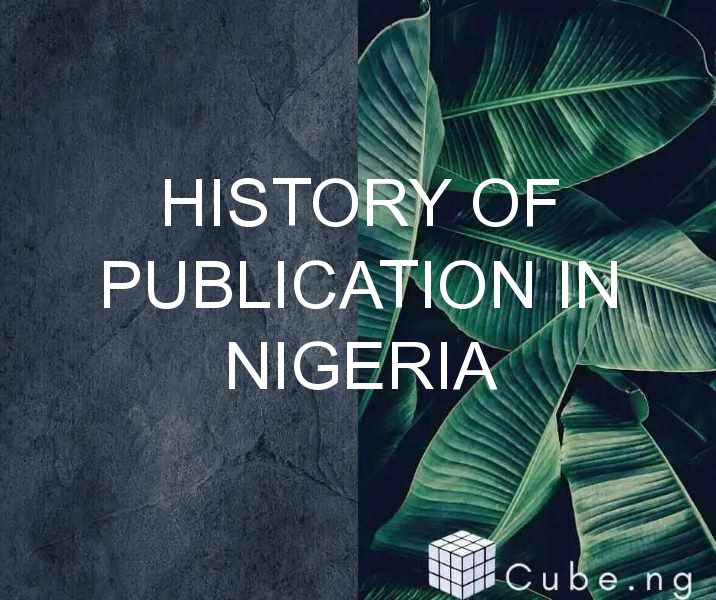Table of Contents
The History of Publication in Nigeria: From Colonialism to Present Day
Nigeria is a country rich in culture and heritage. Its diverse population has contributed immensely to the literary world, with many authors, poets, and scholars hailing from the West African nation. The history of publishing in Nigeria is a long and fascinating one, punctuated by various milestones and challenges. In this article, we will explore the evolution of publishing in Nigeria, from its colonial past to its present-day status as a thriving literary hub.
Colonial Era Publishing in Nigeria
The history of modern publishing in Nigeria can be traced back to the colonial era. The first known book published in Nigeria was "The Holy Bible" in the Yoruba language, which was printed in 1843 by the Church Missionary Society (CMS). The CMS played a significant role in the early years of publishing in Nigeria, as they were responsible for publishing religious texts and materials in indigenous languages.
However, the first book to be published by a Nigerian was a collection of poems titled "The Orrisan Rhapsody" by Samuel Ajayi Crowther, which was published in 1885. Crowther was a Yoruba man who was captured as a slave and later freed by the British. He became the first African bishop of the Anglican Church and a prominent figure in Nigeria's history.
During the colonial era, publishing was largely controlled by the British, who saw it as a means of disseminating western ideas and culture. The Nigerian literary scene was dominated by European publishers, who produced books primarily for the expatriate community. It wasn't until after Nigeria gained independence in 1960 that publishing began to flourish in the country.
Post-Independence Publishing in Nigeria
With Nigeria's independence came a renewed focus on African literature and culture. Nigerian publishers began to emerge, producing books that reflected the country's diverse cultures and traditions. One of the earliest Nigerian publishing houses was Heinemann Educational Books, which was established in 1962. Heinemann played a crucial role in the development of African literature, publishing works by notable authors such as Chinua Achebe, Wole Soyinka, and Chimamanda Ngozi Adichie.
The 1970s and 1980s saw a boom in publishing in Nigeria, with many new publishing houses springing up. The government also established the Nigerian Book Development Council to promote the development of the book industry. However, the industry faced many challenges, including limited funding, poor infrastructure, and piracy. Despite these challenges, Nigerian publishers continued to produce quality literature that reflected the country's rich cultural heritage.
The Digital Age and the Future of Publishing in Nigeria
The advent of digital technology has brought about significant changes in the publishing industry, both in Nigeria and around the world. Electronic publishing has made it easier for authors to produce and distribute their works, while also making books more accessible to readers.
In Nigeria, the rise of digital technology has led to the emergence of new publishing platforms, such as Okadabooks, which allows authors to upload their works and sell them to readers online. Social media platforms like Facebook and Twitter have also provided a space for authors to connect with readers and promote their works.
Despite the challenges facing the industry, publishing in Nigeria continues to evolve and grow. The country's rich literary tradition and diverse population provide a fertile ground for the production of quality literature. With the rise of digital technology and new publishing platforms, the future of publishing in Nigeria looks bright.
Conclusion
The history of publishing in Nigeria is a testament to the resilience and creativity of its people. From its colonial past to its present-day status as a literary hub, Nigeria has produced a wealth of literature that reflects its diverse cultures and traditions. Despite the challenges facing the industry, publishing in Nigeria continues to thrive, thanks to the hard work and dedication of its publishers, authors, and readers.
FAQs
-
What was the first book to be published in Nigeria?
The first known book published in Nigeria was "The Holy Bible" in the Yoruba language, which was printed in 1843 by the Church Missionary Society (CMS). -
Who was the first Nigerian author to be published?
The first book to be published by a Nigerian was a collection of poems titled "The Orrisan Rhapsody" by Samuel Ajayi Crowther, which was published in 1885. -
What challenges has the publishing industry faced in Nigeria?
The publishing industry in Nigeria has faced challenges such as limited funding, poor infrastructure, and piracy. -
What role did Heinemann Educational Books play in the development of African literature?
Heinemann Educational Books played a crucial role in the development of African literature, publishing works by notable authors such as Chinua Achebe, Wole Soyinka, and Chimamanda Ngozi Adichie. -
What is the future of publishing in Nigeria?
With the rise of digital technology and new publishing platforms, the future of publishing in Nigeria looks bright. The country's rich literary tradition and diverse population provide a fertile ground for the production of quality literature.




